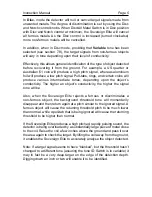
Instruction Manual
Page 5
In Disc. mode the detector will null or cancel target signals made from
unwanted metals. The degree of discrimination is set by using the Disc
and Notch control knobs. When Disc/All Metal Switch is in Disc position
with Disc and Notch control at minimum, the Sovereign Elite will cancel
all ferrous metals. As the Disc control is increased (turned clockwise)
more non-ferrous metals will be cancelled.
In addition, when in Disc mode, providing that Variable tone has been
selected (see section 7.8), the target signals from non-ferrous objects
will vary in tone depending upon their level of conductivity.
Effectively, this allows general identification of the type of object detected
before recovering it from the ground. For example, a US quarter or
Australian $1 coin will produce a high pitch signal, whereas aluminium
foil will produce a low pitch signal. Pull-tabs, rings, and certain coins will
produce various intermediate tones, depending upon the object’s
conductivity. The higher an object’s conductivity, the higher the signal
tone will be.
Also, when the Sovereign Elite rejects a ferrous or discriminates a
non-ferrous object, the background threshold tone will momentarily
disappear and then return again at a pitch similar to the ignored signal. A
ferrous object will cause the returning threshold pitch to be much lower
than normal, while a pull-tab that is being ignored will cause the returning
threshold to be higher than normal.
If the Sovereign Elite produces a high pitched, rapidly pulsing sound, the
detector is being overloaded by a substantially large piece of metal close
to the coil. Raise the coil a few inches above the ground and pass it over
the area again to check the target. By lifting the coil away from the ground,
it enables the Sovereign Elite to accurately analyse the object detected.
Note: If a target signal seems to have “blanked”, but the threshold hasn’t
changed to a different tone (assuring the tone ID Switch is in variable) it
may in fact be a very deep target on the edge of the detection depth.
Digging down an inch or two will enable it to be identified.















































